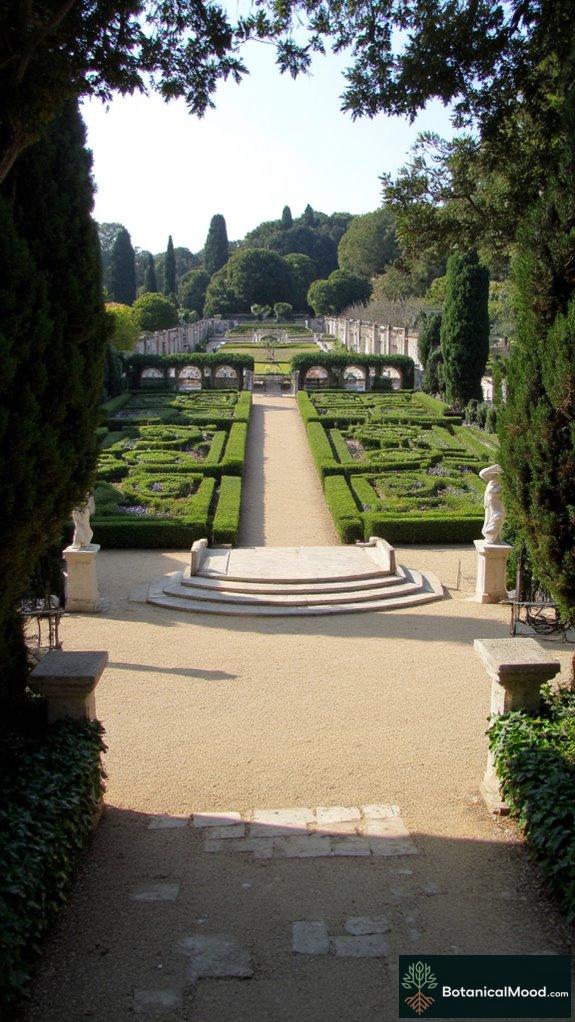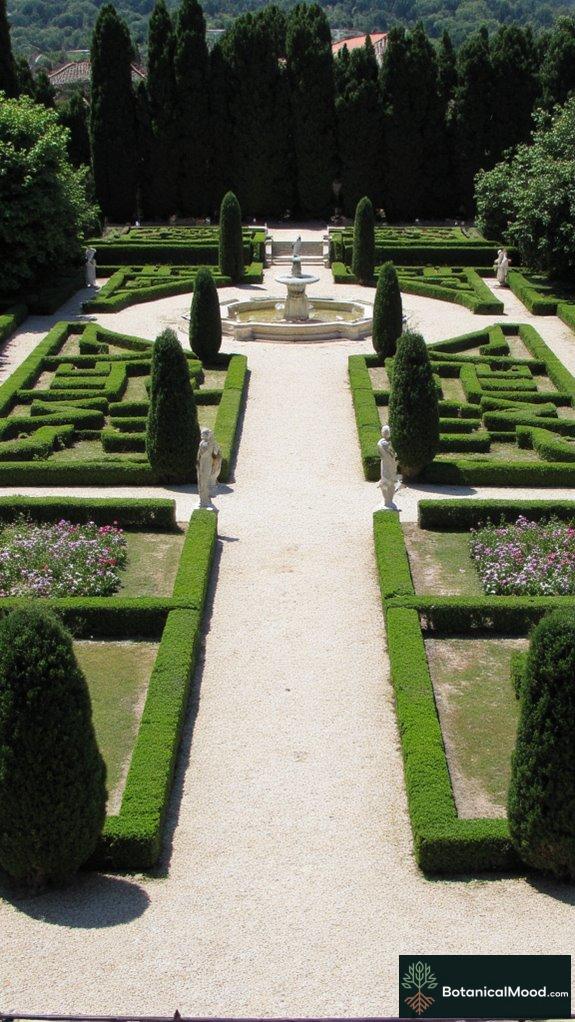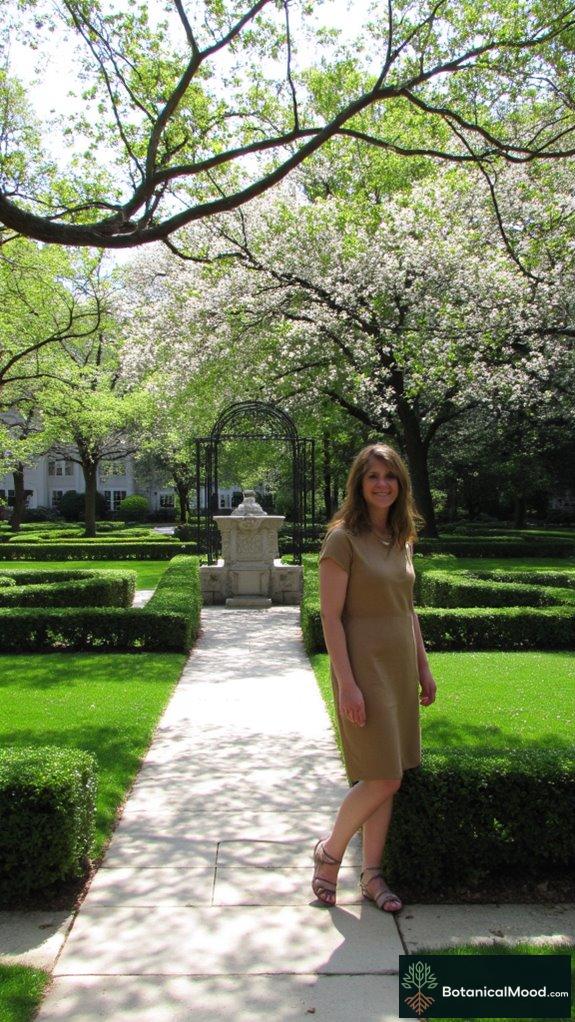Italian Renaissance gardens: what’s the big deal, right?
Well, let me tell you about my magical visit to the Cortile Del Belvedere at Vatican Palace.
This place drips with symmetry and style—central fountains, perfectly clipped hedges, and those insane geometric patterns. It’s like nature got a design degree.
Walking through, I felt the harmony wash over me, like a well-planned Instagram post that actually works!
And honestly, who doesn’t want a slice of that beauty in their own backyard? Just don’t ask me to pick a favorite—floral diplomacy is real!
My Journey to Creating a Symmetrical Garden Inspired by the Renaissance
I once tried to recreate a piece of Villa Madama in my tiny urban backyard. Armed with just a trowel and a Pinterest board, I envisioned elegance but ended up with a lopsided hedge maze.
Each misplaced plant felt like a betrayal of my aesthetic goals. But I learned—gardening isn’t merely about symmetry; it’s about finding peace in the chaos.
Now, I embrace the quirkiness. My “Renaissance” garden is uniquely mine, reminding me that beauty thrives in imperfection, much like the artists I admire.
Quick Takeaways
- Villa d’Este exemplifies harmonious symmetry through its terraced gardens, featuring elaborate fountains and a balanced arrangement of flower beds.
- Boboli Gardens showcase axial symmetry with structured pathways and grand staircases, promoting visual harmony and engagement within its landscape.
- Palazzo Giardino integrates classical sculptures and geometric patterns, reflecting the Renaissance focus on symmetry and elegant architectural elements in garden design.
- Each garden employs water features as central focal points, enhancing the aesthetic appeal through sound, light, and interactive sensory experiences.
- Historical figures like Bramante and Raphael inspire these designs, illustrating the enduring legacy of symmetry in Italian Renaissance garden architecture.
Cortile Del Belvedere, Vatican Palace

The Cortile Del Belvedere, nestled within the Vatican Palace, stands as a remarkable demonstration of the art of Renaissance garden design, capturing my imagination every time I visit.
Its harmonious symmetry enchants, featuring elegant paths framed with magnificent hedges and vibrant flowers. I admire how the geometric layout reflects the ideals of order and beauty championed by artists like Michelangelo and Bramante, whose visions transformed this space.
The cascading terraced slopes and classical sculptures amplify its allure, inviting visitors to explore and feel liberated in nature.
This experience inspires my own passion for garden design, fusing history with the beauty of the present.
Gardens of Villa Madama, Rome

Nestled amidst the splendor of Rome, the gardens of Villa Madama unfold as an enthralling tribute to Renaissance elegance and innovation. Designed by architect Raphael, these gardens boast harmonious terraces adorned with fragrant herbs, vibrant flowers, and meticulously shaped hedges that celebrate the principles of symmetry.
As I wandered through, I admired the stunning vistas framed by rustic stone walls and elaborate fountains, reminiscent of past eras. The allure of Renaissance garden design captivates my spirit, sparking the inspiration behind my website, Botanical Mood, where I explore the art of cultivating natural beauty. These gardens also reflect the essence of minimalist design principles, blending simplicity with beauty in a truly unique way.
Each corner reveals a symphony of colors and forms.
Typical Italian Renaissance Formal Garden Design

In a typical Italian Renaissance formal garden design, order and beauty intertwine to create a stunning vista that offers both aesthetic pleasure and a sense of tranquility. These gardens often showcase symmetrical plantings, neatly trimmed hedges, and elegant pathways, which draw the eye through verdant scenery. Notable figures like Andrea Palladio influenced these layouts, emphasizing harmonious proportions and balance.
| Element | Description |
|---|---|
| Focal Points | Statues or water features |
| Plant Selection | Boxwood, Cypress, and flowering plants |
| Pathways | Gravel or stone, creating structure |
My passion for gardens inspired the creation of Botanical Mood, reflecting the beauty of these timeless designs.
Geometric Patterns in Garden Layout

Geometric patterns play a vital role in the alluring aesthetic of Italian Renaissance gardens, where harmony and order create visually engaging spaces that leave a lasting impression.
As I explore these gardens, I notice how squares, rectangles, and circles establish balanced layouts, extending villa architecture into nature. The use of symmetrical design principles contributes to the gardens’ refined elegance, enhancing their overall impact.
I admire the complex orthogonal grids that guide pathways, revealing clear flowerbeds in precise shapes, often bordered by neatly clipped hedges. Each element, from sculptures to water features, contributes to a cohesive, liberating experience. Italian gardens have a distinct historical context, showcasing the intricate relationship between art and nature in their design.
Inspired by renowned designers like Andrea Palladio, I’ve developed Botanical Mood to celebrate this beauty and precision in garden design.
Symmetrical Garden Layout Techniques

Symmetry serves as a key component in crafting the enchanting layouts of Italian Renaissance gardens, where balance and beauty intertwine seamlessly.
Creating a symmetrical garden layout invites liberation of the spirit, offering a harmonious escape into nature.
To achieve this, I focus on:
- Establishing a central focal point, like a stunning fountain or statue, to draw the eye.
- Utilizing mirrored plant arrangements, where each side reflects the other in color and form, enhancing tranquility.
- Incorporating structured pathways, guiding visitors on balanced journeys through lush greenery, often seen in gardens by famous designers such as Andrea Palladio.
These techniques awaken joy and peace in garden lovers.
Blueprints for Symmetrical Pathways

Creating pathways in Italian Renaissance gardens plays a vital role in crafting an unforgettable experience, guiding visitors through meticulously curated vistas. I’ve found that classic geometric patterns, like squares and circles, provide structure and clarity. Symmetrical grids divide spaces perfectly, while straight-axis paths lead to focal points, enhancing sightlines. The use of paving materials, like brick or stone, with alternating colors accentuates the design. Grand staircases on terraces offer elegant connections, complemented by uniform hedges and flower beds. Inspired by historic beauties like Villa d’Este, I celebrate these designs on my website, Botanical Mood, to inspire others in achieving harmonious garden aesthetics. These gardens reflect the principles of Italian Renaissance design, emphasizing beauty and order through their meticulous layouts.
Fountain-Centered Design Principles

Fountains serve as the heart of Italian Renaissance garden designs, anchoring a sense of balance and grace within these lush settings. Their central positions organize both paths and planting beds symmetrically, guiding visitors through beautifully engineered vistas.
- Water symbolizes purity and life.
- Sculptures convey stories of nature’s mastery.
- Cascades amplify light and sound for sensory delight.
In creating my website, Botanical Mood, I sought to inspire others to appreciate the beauty of these designs, embodying the Renaissance ideals of harmony and celebration. Each fountain forms a dialogue with nature, inviting us to revel in the exquisite artistry of our surroundings. Additionally, these gardens often feature famous historical features such as the ornate fountains in the Bobolis Gardens, further enhancing their visual appeal.
How To Design Italian Renaissance Garden Blueprint Inspiration

Designing an Italian Renaissance garden blueprint requires a thoughtful blend of planning and artistic expression, echoing the rich traditions established by influential figures like Leon Battista Alberti and Andrea Palladio. I envision paths lined with gravel, trees aligned for rhythmic symmetry, and terraces carved into the hills. This style is characterized by strict geometric shapes, which ensure the integrity of the garden’s design.
Here’s a simple table to visualize key elements:
| Element | Importance | Example Feature |
|---|---|---|
| Geometric Layout | Balance & Harmony | Central Axis |
| Water Features | Visual Focal Points | Fountains & Canals |
| Classical Elements | Cultural Connection | Statues & Columns |
Such a design celebrates nature’s beauty while echoing historical grandeur.
Meet the Garden Visionary

Smith, hailing from California, developed a passion for garden design after visiting the historic Villa d’Este in Italy. Inspired by the lush scenery and symmetry of Renaissance gardens, she sought to create her own sanctuary at home.
To bring her vision to life, Smith collaborated with landscape architect John Doe, renowned for his work on classical garden styles. Together, they conducted extensive research and planning, carefully selecting geometric patterns and spatial contrasts to evoke the harmony found in Italian Renaissance gardens. This focus on axial symmetry allowed them to create a visually engaging layout that captures the essence of historical designs.
The design process included sketching layouts and selecting appropriate plant species that aligned with her aesthetic goals.
The transformation utilized tools such as landscape design software and gardening essentials from brands like Fiskars and Troy-Bilt.
Collaborating with horticulturists from the local university, Smith sourced native plants and classical ornamental features, ensuring her garden could flourish and embody the elegance of its Renaissance inspirations.
Renowned Landscape Architects

When exploring the legacy of renowned terrain architects, it’s exciting to discover how they shaped our understanding of garden beauty through their groundbreaking designs.
- Bramante’s structured symmetry at the Vatican Palace ignites admiration for order. He utilized terraces and stairs to enhance the garden’s integration with the surrounding landscape.
- Ligorio’s dramatic water features at Villa d’Este mesmerize with their elegance.
- Raphael’s harmonious terraces at Villa Madama create breathtaking views.
These artists taught us to free our minds through gardens, expressing human creativity alongside nature’s wildness.
As I reflect on their work, I’m reminded why I created Botanical Mood: to celebrate and share the magic of garden design that continues to inspire liberation and beauty.
Garden Design FAQ
What Plants Are Commonly Used in Italian Renaissance Gardens?
In Italian Renaissance gardens, I often see cypress trees, boxwoods, and fragrant herbs like rosemary and lavender. These plants create a sense of order and beauty, inviting me to appreciate the harmony of nature’s design.
How Do Water Features Enhance Garden Symmetry?
Water features enhance garden symmetry by creating balance and reflecting beauty. I’ve found that fountains or ponds draw the eye symmetrically, making the garden feel harmonious and inviting, allowing my spirit to soar amidst nature’s splendor.
What Tools Are Needed for Maintaining Symmetrical Gardens?
To maintain symmetrical gardens, I use tools like shears, rakes, and string lines. I cherish investing in quality equipment; they help me achieve balance and precision, allowing my creativity to flow freely in every design.
Can Modern Gardens Adopt Italian Renaissance Design Principles?
I believe modern gardens can embrace Italian Renaissance design principles to create harmonious, balanced spaces that inspire freedom and creativity. By integrating symmetry and structured pathways, we can cultivate beauty while expressing individuality in our gardens.
What Cultural Influences Shaped the Italian Renaissance Garden Style?
The Italian Renaissance garden style was shaped by classical Roman ideals, humanism, and the desire for harmony with nature. I find these influences reflect a deep appreciation for beauty, balance, and intellectual growth in garden design.
Share Your Own Garden
Designing my Italian Renaissance garden felt like creating a work of art, where every detail mattered. Inspired by symmetry and geometric shapes, I found joy in crafting a space that reflects my creativity. This passion led me to create Botanical Mood for others who share the same love for gardening.
I’d love to hear about your experiences with garden design. What inspires you?
Feel free to share pictures of your own garden and the ideas that shaped it!
References
- https://en.wikipedia.org/wiki/Italian_Renaissance_garden
- http://www.travelingintuscany.com/gardens/italianrenaissancegarden.htm
- https://www.gaiaferroforgiato.it/en/the-italian-renaissance-garden-or-formal-garden/
- https://hardcoreitalians.blog/2024/09/06/the-art-of-italian-gardens/
- https://www.colwynn.com/p/the-history-of-garden-design-italian-renaissance-gardens
- https://www.beculture.it/en/history-and-features-of-the-italian-style-gardens/
- https://gardendesignstoreuk.co.uk/italian_garden_design
- https://www.youtube.com/watch?v=WpO8ZrT_WgE
- https://www.houzz.com/magazine/bring-a-touch-of-renaissance-italy-into-your-garden-stsetivw-vs~33959919
- https://sgira.org/villas10.htm
